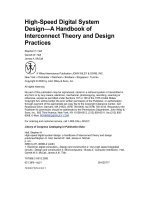handbook of aqueous electrolyte thermodynamics theory amp application
Bạn đang xem bản rút gọn của tài liệu. Xem và tải ngay bản đầy đủ của tài liệu tại đây (12.69 MB, 877 trang )
This page intentionally left blank
MlDBB@@K
@FA
UEOUS
THERMODYNAMICS
ELEC
9
ROLYTE
This page intentionally left blank
BFAQUEOUS
ELECTROLYTE
Theory
&
Application
Joseph
E
Zemaitis,Jr.
Chem Solve,
Inc.
Diane
M.
Clark
OLI
Systems,
Inc.
Marshall Rafal
OLI
Svstems.
Inc.
Noel
C.
Scrivner
E.I.
dubnt
de
Nemours
&
Co.,
Inc.
WILEY-
INTERSCIENCE
A
JOHN
WILEY
&
SONS,
INC.,
PUBLICATION
A publication
of
the
Design Institute
for
Physical Property Data (DIPPR)
Sponsored
by
the
American Institute
of
Chemical Engineers
345
East 47th Street New
York,
New
York
10017
No
part.
of
this publication may be reproduced, stored
in
a retrieval system or transmitted
in any
form
or
by any means, electronic, mechanical, photocopying, recording, scanning
or
otheiwise, except as permitted under Scctions 107
or
108
of thc
1976
United
Statcs
Copyright Act,
without
either the prior written permission of
the
Publisher,
or
authorization through payment of the appropriate per-copy fee to the Copyright
Clearance Center, 222 Rosewood Drive, Danvers,
MA
01923. (978) 750-8400, fax
(978) 750-4470. Requests to the Publisher
for
permission should
be
addressed to the
Permissions Department, John Wiley
&
Sons,
Inc.,
I1
1
River Street, Hoboken, NJ 07030,
(201)
748-6011, fax (201) 748-6008.
0
Copyright
1986
American Institute
of
Chemical Engineers, Inc.
345
East Forty-Seventh Street
New
York,
New
York
10017
All
rights reserved.
No
part of this publication may be reproduced, stored in a retrieval system
or
transmitted
in any form or by any means, electronic, mechanical, photocopying, recording
or
otherwise, without the prior
permission of the copyright owner.
ISBN
978-0-8 169-0350-4
AlChE
shall
not be responsible
for
statements
or
opinions advanced
in
papers
or
printed
in
its
publications.
Dedication:
1
his book is dedicated to the mem-
ory of Dr. Joseph
F.
Zemaitis, Jr.
Dr.
Zemaitis, a colleague and friend
for many years, was responsible for the outline of
this
book and the
writing of the first three chapters. In a larger sense, he provided for
the synthesis
of
a
very diverse body of work into a coherent frame-
work for problem solving. We dearly hope that our dedication
to
and
respect
for
his memory
is
reflected in the content of
this
work.
Diane
M.
Clark
Marshall Rafal
Noel
C.
Scrivner
This page intentionally left blank
Acknowledgment: The authors wish to express their
gratitude to Lisa Perkalis. This book could not have been completed
without her word processing skills, patience and dedication
in
the
face of never-ending “small” changes to the manuscript.
vi
Sponsors: The
DlPPR
sponsors
of
this project,
and the technical representatives who served
on
the steering com-
mittee are listed below. Stars indicate those companies which
sup-
ported the project throughout its three year duration.
Sponsors
of
DIPPR
Project
811
(1 981 -1 983)
Partlclpant
Technical Representative
*Air Products
&
Chemicals, Inc.
Allied Corporation
*Amoco Chemicals Corporation
Chevron Research Company
*Chiyoda Chemical Engineering
&
Construction Co., Ltd.
*E.I.
du Pont de Nemours
&
Company, Inc.
'El Paso Products Company
'Hatcon SD Group, Inc.
Exxon Research and Engineering Co.
Hoff mann-LaRoche, Inc.
Hooker Chemical Company
lnstitut Francais du Petrole
*Institution of Chemical Engineers
M.W. Kellogg Company
Kennecott Copper Corporation
*Kerf McGee Chemical Corporation
*Olin Chemicals Group
'Phillips Petroleum Company
*Shell Development Company
*Simulation Sciences, Inc.
*The Standard Oil Company (SOHIO)
*Texaco, Inc.
'Texasgulf, Inc.
Union Carbide Corporation
Dr. M.S. Benson
Mr.
W.B.
Fisher
Dr. D.A. Palmer
Dr.
W.M.
Bollen
Mr.
T.
Maejima
Dr. N.C. Scrivner
Mr.
K.
Claiborne
Dr.
C.
Tsonopoulos
Dr. C.EChueh
Dr.
R.
Schefflan
Dr.
W.L.
Sutor
Dr.
J.
Vidal
Dr.
6.
Edmonds
Mr.
H.
Ozkardesh
Mr.
D.S.
Davies
Dr.
D.S
Arnold
Mr. W.M. Clarke
Mr. M.A. Albright
Dr.
R.R.
Wood
Dr.
C.
Black
Mr.
TB.
Selover
Dr.
C.
Wu
Mr.
S.H.
DeYoung
Mr.
E.
Buck
Federal
Grantor
*National Bureau
of
Standards
Dr.
H.J.
White, Jr.
'Supported
Project for
3
year
life
This page intentionally left blank
Foreword:
A
n international conference on the ‘Ther-
modynamics of Aqueous Systems” sponsored by the American Institute of Chemical
Engineers (AIChE), the National Science Foundation
(NSF),
and the National Bureau of
Standards (NBS),
was
held in Warrenton, Virginia, on October
22-25,1979.
The papers
presented reflected a great deal of research on electrolyte solutions. However, it
was
apparent that there
was
no fundamental document to tie all of the different information
together and
so
to form a framework for solving real problems.
Therefore, AIChE’s Design Institute for Physical Property Data (DIPPR) decided to
publish this book to meet such a need. Through a cooperative effort by participating
corporations, different correlations have been compiled and objectively compared to
experimental data, in regions of industrial interest. Effective methods of finding and using
data are also described. The
Handbook
incorporates and extends previous work in a
well-organized, easy to understand format, with a focus on applications to serious
industrial problems.
It
will become a cornerstone in the study of aqueous electrolyte
thermodynamics.
Electrolyte mixtures come in various forms and add another dimension to the normal
complexities of nonelectrolyte solutions: entirely new species can form in water, some of
which are not obvious; components can precipitate; soluble components can affect the
vapor pressure
of
the solution very significantly.
In
industrial applications, the solutions
are often highly concentrated and encounter high pressures and temperatures. There-
fore expertise in electrolyte systems has become increasingly critical in oil and gas
exploration and production,
as
well
as
in the more traditional chemical industry opera-
tions.
A
variety of correlations are available that can solve the problems that are
encountered
in
industry, but which ones work best? This comprehensive handbook not
only provides easy access to available data but also presents comparative studies of
various correlations up to extreme conditions.
As the Chairman of the Technical Committee of AIChE’s Design Institute for Physical
Property
Data,
I
conceived this cooperative research project and chose
as
its leader, Dr.
Noel
C.
Scrivner of the
E.I.
duPont de Nemours Company, one of the leading practi-
tioners
of
electrolyte thermodynamics.
With
his expertise and enthusiasm, Dr. Scrivner
defined the work that needed
to
be accomplished, promoted the project until it
was
funded, and directed its completion. He
was
elected to head the steering committee of
representatives from the supporting companies.
The initial work
was
carried out in
1981
by the Electrolyte Data Center of the National
Bureau of Standards, under the direction
of
Dr.
B.R.
Staples. That work continued
throughout the project, generating the bibliographies for electrolyte systems. One of
these bibliographies, developed by R.N. Goldberg, is included in this volume.
A
significant portion of the project funding came from the Office of Standard Refer-
ence Data of the NBS (Dr. David
R.
Lide, Jr., Director). The NBS liaison to DIPPR
was
Dr.
Howard
J.
White, Jr. DIPPR provided additional funding along with administrative and
technical assistance.
The task of creating the actual handbook
was
given to the late Dr. Joseph
F.
Zemaitis,
Jr., owner of Chem Solve, Inc. His intellectual contribution to this project will remain as
his legacy. He wrote the first few chapters and carefully outlined the remainder
of
the
book.
His principal colleague in this work,
Ms.
Diane
M.
Clark, dedicated several years
of
creative effort
to
take the outline and complete the project. Another
colleague
of
Or.
Zemaitis,
Dr.
Marshall Rafal, owner of
OLI
Systems, Inc., assumed the contractor’s
responsibility
for
execution
of
the handbook and contributed some
of
the writing.
Dr.
Scrivner gave technical direction and technical contributions to assure that the
work
would meet the standards set by the steering committee.
This
book
is
dedicated to
Dr.
J.F.Zemaitis. Dr. David
W.H.
Roth,
Jr.,
the administrative
committee chairman
of
DIPPR,
and
I
would like to express sincere appreciation to the
other authors, the steering committee members, the corporate sponsors, and the
National Bureau
of
Standards.
David
A.
Palmer,
Chairman
DIPPR
Technical Executive Committee and
DIPPR
Technical Committee
X
TABLE
OF
CONTENTS
I
I1
111
IV
INTRODUCTION
THERMODYNAMICS
OF
SOLUTIONS
Basic Thermodynamic Functions
Solutions
-
Basic Definitions and Concepts
Equilibrium
-
Necessary Conditions
Activities, Activity Coefficients and Standard States
EQUILIBRIUM CONSTANTS
Ionic andlor Reaction Equilibrium in Aqueous Solutions
Solubility Equilibria Between Crystals and Saturated Solutions
Vapor-Liquid Equilibria in Aqueous Solutions
Temperature Effects on the Equilibrium Constant
Estimating Temperature Effects on Heat Capacity and Other
Equilibrium Constants from Tabulated Data
Pressure Effects on the Equilibrium Constant
Appendix
3.1
-
Criss
and Cobble Parameters
ACTIVITY COEFFICIENTS OF SINGLE
STRONG
ELECTROLYTES
Thermodynamic Properties
History
Limitations and Improvements to the Debye-Huckel Limiting Law
Further Refinements
Bromley's Method
Meissner's Method
Pitzer's Method
Chen's Method
Short Range Interaction Model
Long Range Interaction Model
Temperature Effects
Bromley's Method
Meissner's Method
Pitzer's Method
Chen's Method
Bromley's Method
Meissner's Method
Pitzer's Method
Chen's Method
NBS Smoothed Experimental Data
Test
Cases:
Application
HC1
K
C1
KOH
NaCl
NaOH
CaCl2
Na2SO4
MgSOO,
Bromley's Extended Equation
MgS04 Test Case
1
11
13
14
16
17
25
27
30
31
32
33
36
36
39
45
48
55
56
64
67
71
76
76
82
84
84
84
86
89
90
91
93
94
96
98
99
103
106
110
113
117
121
124
127
128
Comparison
of
Temperature Effect Methods
B
romley
Meiss ner
Pitzer and Chen
Experimental Data
Test Cases
:
HC1
at
50'
Celsius
KC1 at
80'
Celsius
KOH
at
80°
Celsius
NaCl at
100
and
300'
Celsius
NaOH at
35O
Celsius
CaClz at
108.85
and
201.85'
Celsius
Na2S04 at
80°
Celsius
MgS04 at
80'
Celsius
Appendix
4.1
-
Values
for
Guggenheim's
0
Parameter
Table
1
:
B
Values for Uni-univalent Electrolytes
Table
2:
0
and
B
Values of Ri-univalent and Uni-bivalent
Methods for Calculating
8
Table
1:
B
Values at
25'C
Determined by the Method of Least
Squares on Log
Y
to
1=6.0
(or
less
if
limited data)
Table
2:
Individual Ion Values
of
B
and
6
in Aqueous Solutions
at
25OC
Table
3:
Bivalent Metal Sulfates at
25OC
Table: Average Values
of
Parameter q in Equation
(4.46)
Electrolytes from Freezing Points
Appendix
4.2
-
Bromley Interaction Parameters
Appendix
4.3
-
Meissner Parameters
for
Selected Electrolytes
Table
1:
Inorganic Acids. Bases and Salts of
1-1
Type
Table
2:
Salts of Carboxylic Acids
(1-1
Type)
Table
3
:
Tetraalkylammonium Halides
Table
4:
Sulfonic Acids and Salts
(1-1
Type)
Table
5:
Additional
1-1
Type Organic Salts
Table
6:
Inorganic Compounds of
2-1
Type
Table
7:
Table
8:
3-1
Electrolytes
Table
9: 4-1
Electrolytes
Table
10: 5-1
Electrolytes
Table
11:
2-2
Electrolytes
Table
1:
Temperature Derivatives of Parameters for
1-1
Electrolytes Evaluated from Calorimetric Data
Table
2:
Temperature Derivatives of Parameters for
2-1
and
1-2
Electrolytes Evaluated from Calorimetric Data
Table
3:
Temperature Derivatives
of
Parameters for
3-1
and
2-2
Electrolytes
from
Calorimetric Parameters
T
Values Fit for 5:olality Mean Ionic Activity Coefficient
Data of Aqueous Electrolytes at
298.15
K
Appendix
4.4
-
Pitzer Parameters
Organic Electrolytes of
2-1
Type
Appendix
4.5
-
Pitzer Parameter Derivatives
Appendix
4.6
-
Chen Parameters
Table:
V
A
CT
IV
IT
Y
CO
E
FF
ICIE
NTS
0
F
MU
LT
1
CO
hlP
ON
E
NT
ST
RO
NG
ELECTROLYTES
Guggenheim's Method for Multicomponent Solutions
130
130
131
131
132
133
136
140
144
150
153
159
162
165
165
166
167
170
170
173
174
175
175
179
179
131
181
182
183
183
185
185
18t1
18
7
187
188
188
189
190
19
1
191
205
209
xii
Bromley's Method
for
Multicornponent Solutions
Activity Coefficients
of
Trace Components
Meissner's Method
for
hlulticoinponent Solutions
Pitzer's Method
for
Multicomponent Solutions
Chen's Method for Multicomponent Solutions
Application
Guggenheiin's Method
Broinley's Method
Meissner's Method
Pitzer's Method
Water Activities
B
romley's Water Activity
Pdeissner's Water Activity
Pitzer's Water Activity
Phase Diagram Calculations
Basic
flow
of
the testing program
Program block descriptions
H:O
-
NaCl
-
KC1
H20
-
NaCl
-
HC1
H20
-
NaCl
-
NaOH
Hz0
-
KC1
-
HC1
Hz0
-
NaCl
-
CaC12
H$I
-
NaCl
-
MgC12
I120
-
NaCl
-
NaeSOs
HzO
-
KC1
-
CaC12
I120
-
NaOH
-
Na2S04
Hz0
-
NaCl
-
CaSOs
H20
-
HCI
-
CaS04
H20
-
CaC12
-
CaS04
H20
-
Na2S04-CaSOk
Ii20
-
MgS04
-
CaSOb
Appendix
5.1
-
Values
for
Pitzer's
0
and
J,
Parameters
Table
1:
Parameters for mixed electrolytes with virial
Table
2:
Effects
of
Higher-order Electrostatic Terms
Table
3:
Parameters
for
binary mixtures with
a
common
coefficient equations (at
25OC:)
Parameters
for
the virial coefficient equations
at 25OC
ion
at
25OC
VI
ACTIVITY COEFFICIENTS
OF
S'TKONGLY COMPLEXING COMPOUNDS
Identification
of
Complexing Electrolytes
Literature Review
Use
of
Meissner's Curves
Comparison
of
Osmotic Coefficients
Phosphoric
Acid
Sulfuric Acid
Zinc
Chloride
Ferric Chloride
Cuprous Chloride
Calcium Sulfate
Sodium Sulfate
Other Chloride Complexes
Manganous Chloride
Cobalt Chloride
211
212
214
2
19
223
23
1
232
234
235
236
238
238
240
24
1
242
243
245
250
261
268
278
29
0
299
315
326
335
347
357
363
369
377
384
394
385
386
389
39
9
406
407
407
407
409
415
419
424
428
43
1
436
440
440
443
xiii
Nickel Chloride
Cupric Chloride
Activity Coefficient Met hods
Summary
Appendix
6.1
-
Cuprous Chloride
Table
la:
Interaction Parameters
Table lb: Three Parameter Set
Table
2:
Equilibrium Constants and Heats
of
Reaction
Table 3a: Equilibrium Constants and Changes in Thermodynamic
Properties
for
Formatiog-of CuC1; and c'uC1;- from
CuCl(s)
+
nC1-
=
CuC1,+1
Table 3b: Equilibrium Constants and Changes
in
ThermodynRmic
Properties
for
Formtttio
of
CuCI; and CuC1:- from
cu+
t
nC1-
=
cucly-lf
VII
ACTIVITY COEFFICIENTS OF
WEAK
ELECTROLYTES
AND
MOLECULAR
SPECIES
Setschihow Equation
Salting Out Parameter Determination
by
Randall and Pailey
Salting Out Parameter Determination by Long and McDevit
Salting Out Parameter Determination by Other Authors
Edwards, Maurer, Newman and Prausnitz Pitzer Based Method
Beutier and Renon's Pitzer Based Method
Chen's Pitzer Based Method
Predictions Based upon Theoretical Equations
Ammonia
-
Water
Carbon Dioxide
-
Water
Ammonia
-
Carbon Dioxide
-
Water
Sulfur Dioxide
-
Water
Oxygen
-
Sodium Chloride
-
Water
Conclusions
Pitzer Based Equations
Appendix
7.1
-
Salting Out Parameters for Phenol in Aqueous Salt
Appendix
7.2
-
Salting Out Parameters from Pawlikowski and Prausnitz
Solutions at
25O
Celsius
for Nonpolar Gases in Common Salt Solutions
at
Moderate Temperatures
Lennard
-
Jones Parameters for Nonpolar Gases as
Reported by Liabastre (S14)
Salting Out Parameters
for
Strong Electrolytes in Equation
(7.18) at
25OC
Temperature Dependence of the Salting Out Parameters
for
Equation (7.19)
Salting Out Parameters
for
Individual
Ions
for Equation
(7.20)
Temperature Dependence
of
the Salting Out Constants
for
Individual
Ions
Table
1:
Table
2:
Table 3:
Table
4:
Table
5:
VIII
THERMODYNAMIC FUNCTIONS
DERIVED
FROM ACTIVITY
C
0
E
F
F
I
C
I
E
N
T
S
Density
Binary Density
Multicomponent Density
Strong Electrolytes Which Complex
Weak Electrolytes
447
449
453
455
457
457
457
458
458
459
479
485
486
491
496
5
03
503
505
512
517
517
524
524
524
524
524
538
540
540
540
541
542
542
551
554
554
558
558
5
59
xiv
Temperature
Effects
Illustrative Example
Heat of Formation at Infinite Dilution
Enthalpy
Molecular Species
Ionic Species
Range of Applicability
Excess Enthalpy
Example
IX
WORKED
EXAMPLES
Model Formulation
Obtaining Coefficients
Model Solution
Specific Examples
Sodium Chloride Solubility
Water
-
Chlorine
Water
-
Ammonia
-
Carbon Dioxide
Water
-
Sulfur Dioxide
Chrome Hydroxides
Gypsum Solubility
Water
-
Phosphoric Acid
Table
-1
:
Table
2:
Table
3
:
Table
4
:
Table
5
:
Appendix
9.1
-
Parameters for Beutier and Renon's Method
Temperature fit parameters for equilibrium constants
Temperature fit parameters for Henry's constants
Pitzer ion-ion interaction parameters
Temperature fit molecule self interaction parameters
Dielectric effect parameters
Appendix
9.2
-
Parameters
for
Edwards, Maurer, Newman and
Prausnitz Method
Table
1
:
Table
2:
Table
3
:
Table
4
:
Table
5
:
Molecule-ion interaction parameters
Table
1
:
Pure component parameters
Table
2:
Table
3
:
Interaction parameter
a92
for polar-nonpolar mixtures
Table
4:
Table
5
:
Temperature fit parameters for equilibrium constants
Temperature fit parameters for Henry's constants
Ion-ion interaction parameters
Temperature fit molecule self interaction parameters
Appendix
9.3
-
Fugacity Coefficient Calculation
Nonpolar and polar contribution to parameters
a
and
B
for
four
polar gases
Parameter
a12
for
binary mixtures of nonpolar gases
Interaction parameter
aL
for polar-polar mixtures
Appendix
9.4
-
Brelvi and O'Connell Correlation for Partial Molar
Volumes
Table
1
:
Characteristic volumes
Appendix
9.5
-
Gypsum Solubility Study Parameters at
25OC
Table
1:
Binary solution partimeters
for
the Pitzer equations
Table
2:
Mixed electrolyte solution parameters for the Pitzer
equations
Table
3:
Gypsum solubility product at
25OC
560
560
563
564
564
566
567
568
568
575
577
584
586
588
589
595
606
641
650
663
675
683
683
683
684
685
685
69
1
691
691
692
692
693
699
700
701
701
702
703
704
705
706
706
706
706
X. AP
P
EN
D1
CES
?ll
APPENDIX A
-
COMPUTER PROGRAMS FOR SOLVING EQUILIBRIA 713
PROBLEMS
APPENDIX B
-
SELECTED THERMODYNAMIC DATA 721
APPENDIX
C
-
COMPILED THERMODYNAMIC DATA SOURCES
FOR
737
AQUEOUS AND BIOCHEMICAL SYSTEMS: An
Annotated
Bibliography
(1930
-
1983)
INDEX
843
xvi
NOMENCLATURE
A
-
Debye-Huckel constant,
log
base
10,
equation
(4.31)
A+
-
Debye-huckel constant
for
osmotic coefficients,
log
base e,
A'
-
Debye-Huckel constant for activity coefficients,
log
base e,
equation
(4.64)
equation
ai
-
activity
of
species
i.
equation
(2.21)
at - parameter used by Criss and Cobble's correspondence
principle, equation
(3.32)
aW - water activity
a
-
distance
of
closest approach
or
core size. equation
(4.33)
n
-
parameter
for
Guggenheim's activity coefficient equation, log
B
- interaction parameter
for
Bromley's activity coefficient
BY
- parameter in Pi tzer's activity coefficient equation,
10
basis. equation
(4.39)
equation, equation
(4.44)
equations
(4.63). (4.66)
bt
-
parameter used by Criss and Cobble's correspondence
C9
,Cp - heat capacity
Cpo
-
partial molal heat capacity
C
-
molarity
C
-
salt concentration in the Setschgnow equation
(7.1)
D
-
dielectric constant. equations
(4.11,
(4.98)
d
-
solution density, equation
(2.341,
Chapter
Vlll
dL
-
solvent density
dW
- pure water density, equation
(4.98)
E
-
intrinsic energy
e
-
electronic charge. equation
(4.2)
principle, equation
(3.32)
-
Pitzer parameter, equation
(4.65)
-
xvii
F
f
fY
f
V
gi
G
-
Gi
gi
j
H
H
-
Hi
I
K
Ka q
KS
P
KT
-
ko
k
k
L
M
MS
m
NA
"i
P
-
NRTL
parameter of
equations
(4.701,
-
rational activity
(2.33~)
-
Pitzer electrosta
-
fugacity of vapor
Chen's activity
(4.71)
coefficient (mo
coefficient equation,
e
fraction based), equation
ic function, eq ation
(4.52)
species
V.
equation
(3.20)
-
number of grams of
i,
i=O
for solvent
-
Gibbs free energy
-
partial molar Gibbs free energy, equation
(2.14)
-
radial distribution function, equation
(4.51)
-
enthalpy
-
Henry'
s
constant
-
partial molar enthalpy, equation
(2.15)
-
ionic strength, equation
(4.27)
-
equilibrium constant, dissociation constant
-
equilibrium constant. equation
(3.18)
-
solubility product, equation
(3.13)
-
thermodynamic equilibrium constant, equation
(3.6)
-
partial molal compressibility, equation
(3.40)
-
Boltzmann's constant, equation
(4.2)
-
Setschhnow salt coefficient, equation
(7.1)
-
Ostwald coefficient
-
solute molecular weight. equation
(2.34)
-
solvent molecular weight, equation
(2.34)
-
molality
-
Avagadro'
s
number, equation
(4.2)
-
number
of
moles
of
i
-
pressure, total vapor pressure
-
partial pressure
=
-log
K
-
Meissner's interaction parameter, equation (4.46)
-
gas law constant
-
radius of the field around an ion, equation (4.la)
-
entropy
-
gas solubility in pure water, Setschenow equation
(7.1)
-
gas solubility in salt solution. Setschenow equation
(7.1)
-
temperature, Kelvins
-
temperature, Celsius
-
volume
-
partial
molar
volume, equation (2.16)
-
liquid mole fraction
-
vapor mole fraction
-
any extensive thermodynamic property, equation
(2.8)
-
molar activity coefficient, equation (2.3313)
-
number of charges on ion
i
-
Debye-Huckel constant,
log
base
e
-
nonrandomness factor in Chen's equation for
act
cients, equation (4.70)
-
parameter
in
correspondence principle equation,
(3.36a)
vity coeffi-
equation
-
parameter
for
Gugyenheim's activity coefficient equation.
equation
(4.38)
-
parameter
in
correspondence principle equation, equation
-
Pitzer interaction coefficient
(3.36b)
-
Yitzer interaction coefficient
-
Pitzer interaction coefficient
r
-
reduced activity coefficient, equation
(4.45)
Y
- molal activity coefficient, equation
(2.22)
6
-
Bromley parameter
for
the additive quality of ion interac-
tion, equation
(4.45)
€gas - Lennard-Jones energy interaction, equation
(7.18)
Oij
- Pitzer's coefficient for like charged ion interactions,
vi
-
partial molar Gibbs free energy
or
chemical potential,
equations
(5.321,
(5.33)
equation
(2.17)
uiO
- reference state chemical potential. equation
(2.21)
V
-
sum of cation and anion stoichiometric numbers
V
-
harmonic mean of
v+
and
v-,
equation
(4.38)
-
vi
-
stoichiometric number of ion
i
n
-
osmotic pressure, equation
(4.51)
P
- charge density, equation
(4.1)
T
-
NWTL
binary interaction parameter
of
Chen's activity
coefficient equation. equations
(4.70). (4.71)
,4
-
osmotic coefficient, equation
(2.30)
$a
-
ionic atmosphere potential, equation
(4.14)
J'ijk
-
Pitzer triple ion interaction parameter, equation
(5.32)
Jlr
-
ionic potential
$t
-
total electric field potential, equation
(4.1)
Q
-
apparent molal volume
Subscripts
:
A
-
anion
a
-
anion
C
-
cation
C
- cation
g
-
gas
1
-
any species
j
-
any species
L
-
liquid
m
-
molecular species
S
-
sal
t
U
-
molecular (undissociated species
V
-
vapor
W
-
water
1,3,5
.
-
cations
2.4,6,
.
-
anions
*
-
molecular species
Superscripts
:
el
-
electrostatic
ex
-
excess
lc
-
local composition
P
-
Pitzer long range contribution of Chen's equation, equation
(4.87)
tr
-
trace amount
0
-
indicates reference state of pure (single solute) solutions
u
-
infinite dilution
This page intentionally left blank









